“Jagannatha Trio” has been added to your cart.
View cart
-
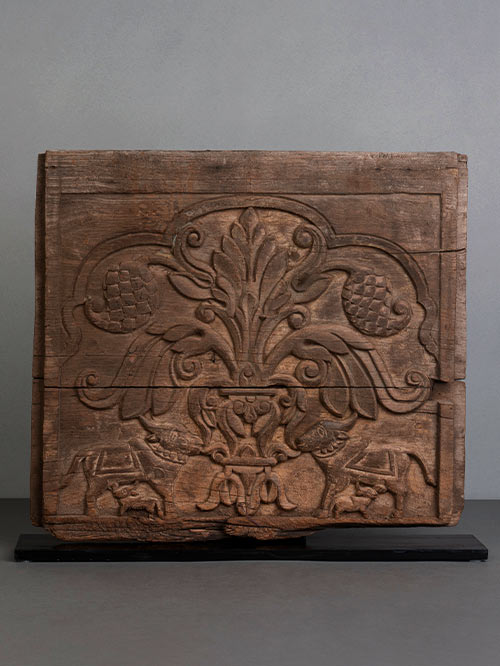
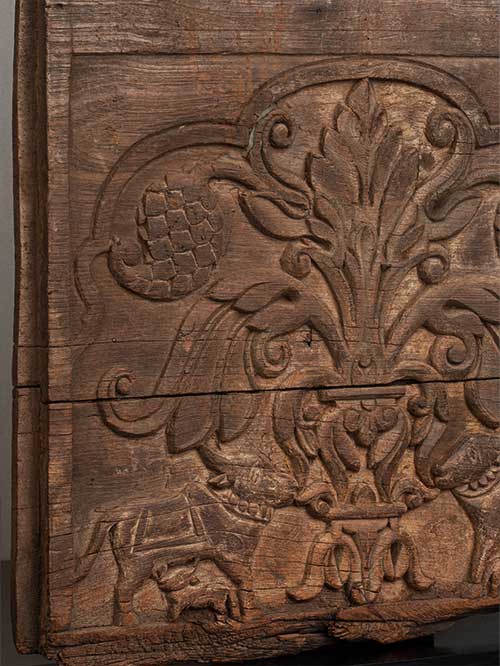
Deccan
Wood
This exemplary carved panel is delicately adorned with a central floral sprig, from which two custard apples (sitaphal) gracefully sprout. Beneath them, a pair of domesticated bulls graze on the low-hanging leaves, while a pair of diminutive calves suckle at their teats. The scene is enclosed within a trefoil archway.
Wooden construction was once widespread throughout most of Southern India, but the intense heat and the severe monsoonal rains have meant that a large proportion of the wooden buildings in private and public use have now disappeared. The typical southern Indian wooden building, was supported on a framework of columns, with an elaborate system of interlocking brackets and beams to support the floors and roofs. Carved doors, windows, and screens and panels filter light and ventilate the interiors, creating an environment that is both comfortable and richly detailed. The scale and shape of houses was dictated by the maximum height and span of timber beams, resulting in a modular system of construction. The woodwork was deeply cut and naturalistic, the intention of the artisans was to capture the forms and energies of the natural world. Panels such as these, with floral medallions radiating in full bloom or others with elaborate geometric modelling, ornamented of palaces, houses and temples.
Size (cms): 43(H) x 51(W) x 9(D)
Size (inches): 17(H) x 20(W) x 3.5(D)
-
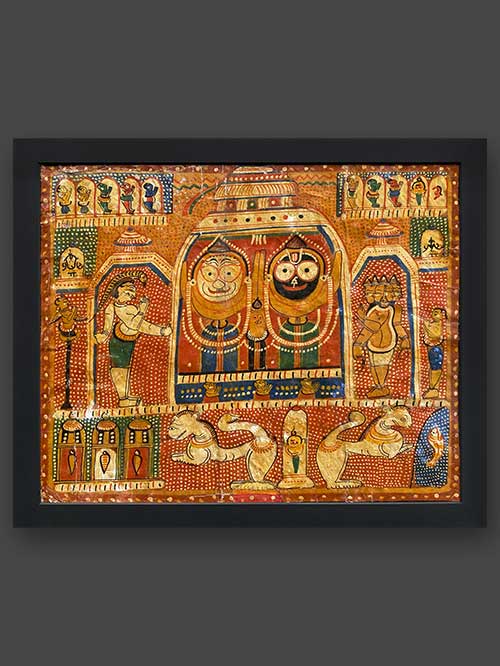
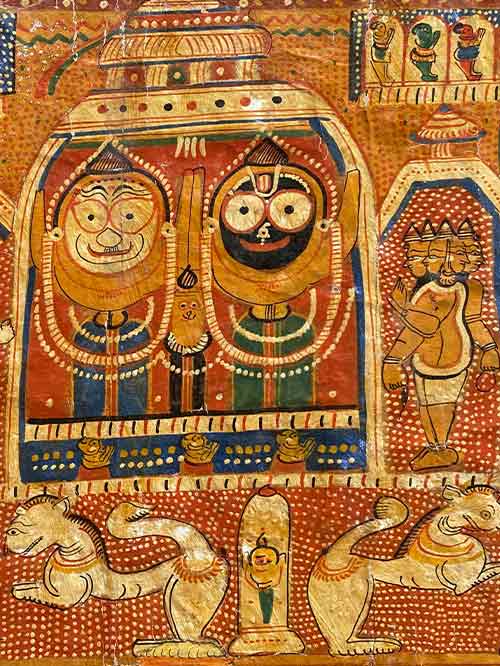
Orissa, Puri district
Gouache and lacquer on cotton cloth
The Jagannatha temple complex dominates the diagram, featuring the central shrine within a towering shikhara. Two male figures, Jagannatha and Balabhadra, are depicted dancing with raised yellow wing-like ‘arms’, while the female Subhadra stands between them. Below the central shrine, panels show priests with hands joined in prayer. To the left of the central trio is Shiva, portrayed in white with a serpent crown, also in a prayerful pose. On the right, multi-headed Brahma is depicted, offering reverence to the central deities. At the base of the temple, a pair of leogryphs forms the Lion Gate, with a small image of Jagannatha enclosed in a shrine inbetween. Flanking the temple shikhara at the top are the ten avatars of Vishnu, with Jagannatha replacing Buddha as the ninth avatar.
Puri painting, one of India’s oldest popular iconic traditions, is associated with the regional cult of Jagannatha, a manifestation of the god Vishnu, and with the ancient pilgrimage centre of Puri in Orissa on the eastern coast of India on the Bay of Bengal, where the cult took hold. The painting tradition evolved to serve the cult, with painters playing an important role. This type of painting was produced for pilgrims to carry home for display and private worship of the Jagannatha trinity. The image also provides pilgrims with a visual aid to remembering and renewing the entire pilgrimage experience, that is, visiting not only Jagannatha temple but also other shrines in the environs and being present for various daily or festival ritual activities.
Size (cms): 33.5(H) x 41(W)
Size (inches): 13(H) x 16(W)
-
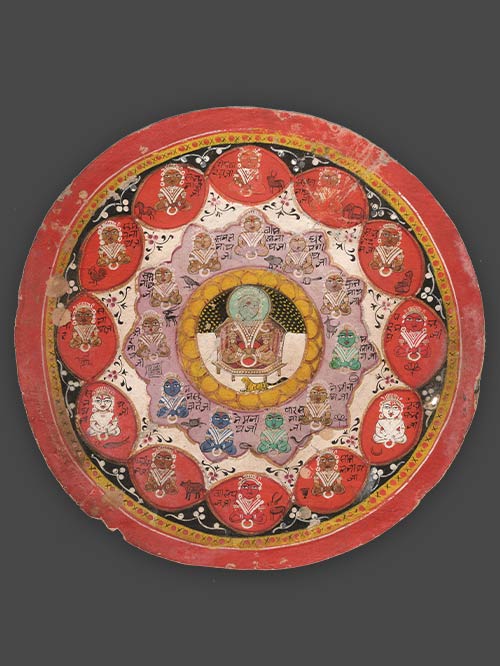

Rajasthan
Opaque watercolour on paper
A beautiful roundel in the shape of a stylised lotus flower. At its center rests Lord Mahavira sitting on an octagonal throne. A group of eleven jinas surround him. The outer border depicts the remaining twelve jinas. Each jina is depicted with a symbol and writing identifying them. This is most probably an insert from a portable prayer box used by the Jain community while travelling.
Size (cms): 14.5(H) x 14.5(W)
Size (inches): 5.5(H) x 5.5(W)
-
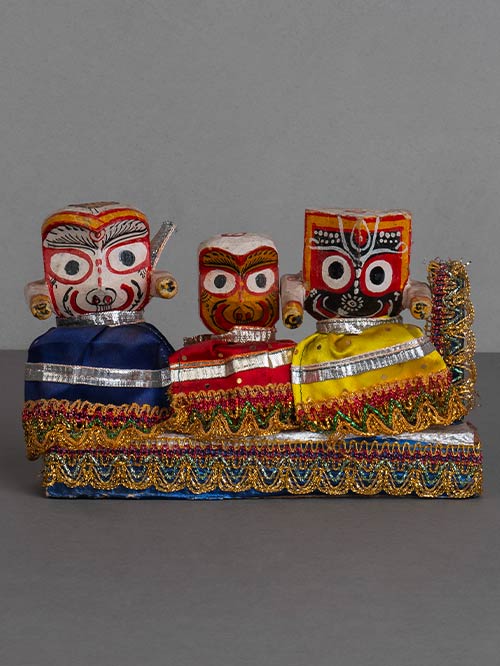
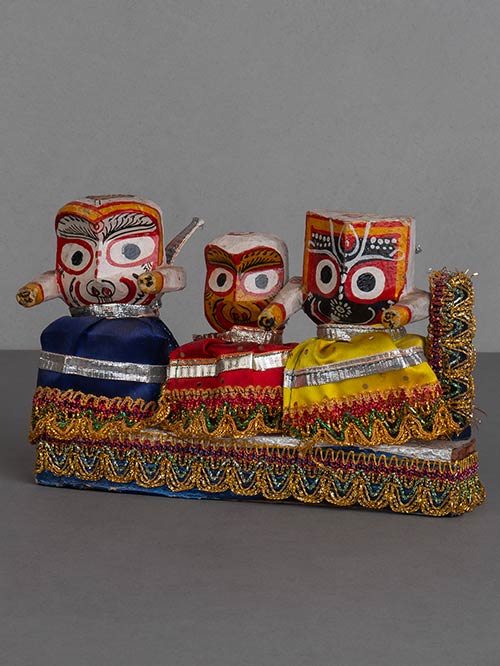
Puri (Orissa)
Wood, polychromed
In the heart of Puri lies the ancient pilgrimage centre and temple of the Jagannatha cult. There, Jagannatha, a form of Krishna, the eighth incarnation of Vishnu, is worshipped along with his brother Balabhadra and sister Subhadra. These diminutive portable figures were produced in the markets surrounding the Jagannatha temple and bought by pilgrims on their journey home. The figures are depicted as legless posts surmounted by large heads. Jagannatha (black faced) and Balabhadra (white faced) and the petite Subhadra (yellow faced).
The cult of Jagannatha in Puri is one of India’s oldest popular iconic traditions. Puri lies in Orissa is on the eastern coast of India in the Bay of Bengal. The figures of the gods remain in the temple for most of the year, but in the rainy season (June or July), they are installed in huge chariots and pulled through the streets of Puri to another temple, allowing the public to have Darshan (‘a holy view’) of the deities as they pass. It is from the huge chariots carrying Jaganath and his siblings that the English word ‘Juggernaut’ originates. Smaller figures such as these may have been used in home altars or shrines.
Size (cms): 14(H) x 21(W) x 5(D)
Size (inches): 5.5(H) x 8.5(W) x 2(D)
-
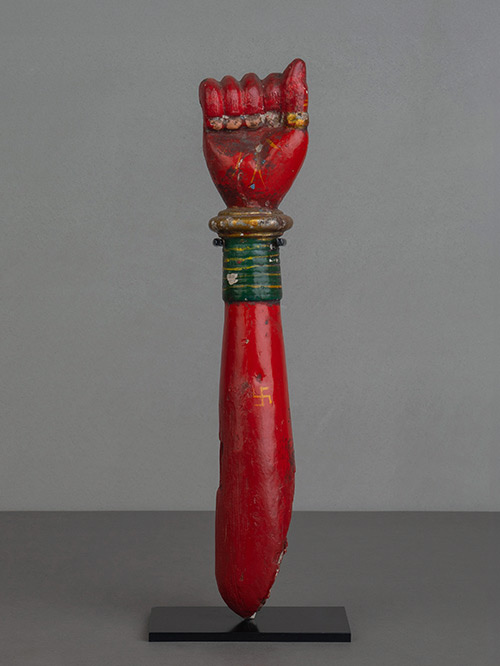
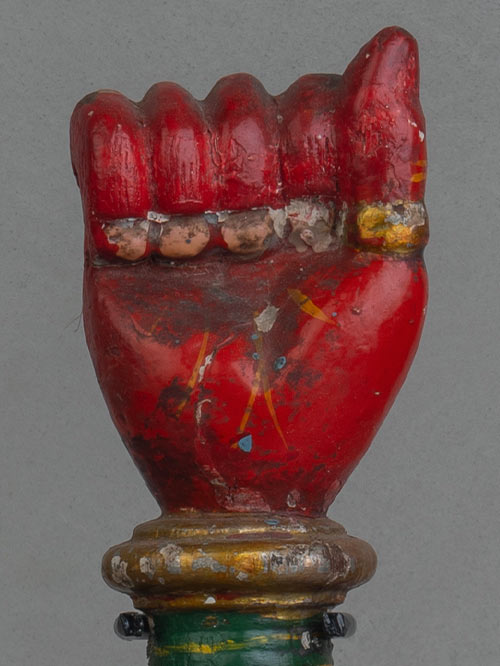
Karnataka
Wood, polychromed
A finely carved wooden hand, with original polychroming wearing bangles. Her hand is held in a clenched fist. Originally from an articulated multi-armed processional figure of a Devi. During festive occasions, the utsavar (portable figures of deities) are placed on chariots or pedestals in the mandapam (audience hall of a temple) or on their respective vahana (vehicle) and taken out for public viewing or darshana. Darshana refers to the occasion where the devotee is not only able to see the image of the deity but also to sense its omnipresence. To enhance the visibility of the utsavar, they are elaborately dressed in dhoti or sari, garlanded with flowers and decked with the most exquisite jewellery, made of gold and semi-precious stones before being brought out in procession. Sometimes additional hands or legs are added to increase the physical presence of the image. These features may allow the deity to stand, sit or clasp multiple weapons.
Size with the Stand (cms): 36.5(H) x 13(W) x 7.5(D)
Size with the Stand (inches):14.5(H) x 5(W) x 3(D)
-
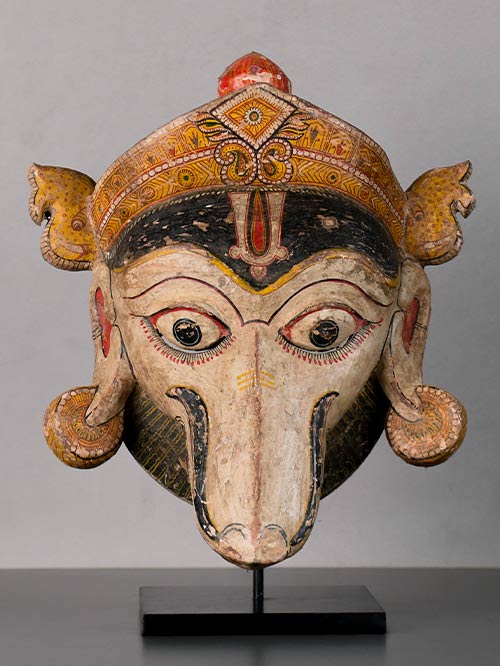
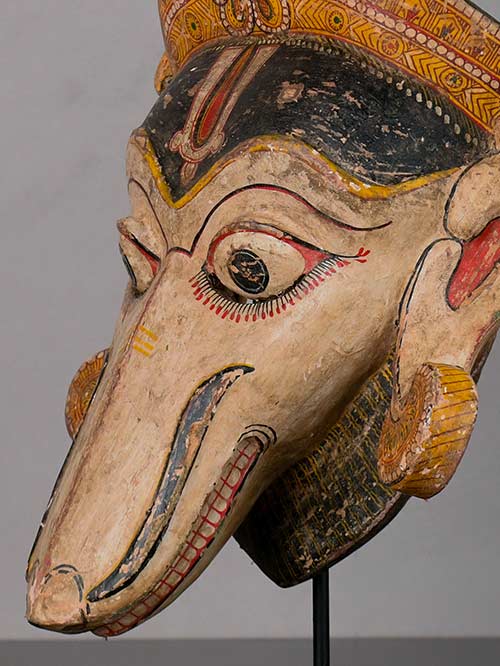
Orissa
Wood, polychromed
This delicately painted dancing mask of Jambavan. Jambavan was the King of the bears and an ally of Lord Rama in the battle of Lanka His wears an elaborate painted crown and a pairs of ear ornaments. A prominent vaishnavite naman adorns his forehead and his elongated curly moustache runs along his snout. The mask would have been used during folk performances of the Ramalila in Orissa.
Shahi Jatras (royal processions) of Orissa present different episodes from the Ramayana during the spring season, usually lasting for for one week. Actors, carrying huge wooden masks and gorgeous costumes, walk on the streets with stylised gait and mime with the accompaniment of loud drumming. The Desia Nata of Koraput, Orissa, also uses masks for representing gods, goddesses, animals, birds and demons. These themes are also taken from Ramayana.
Mask Size (cms): 54.6(H) x 45.7(W) x 26(D)
Mask Size (inches): 21.5(H) x 18(W) x 10(D)













